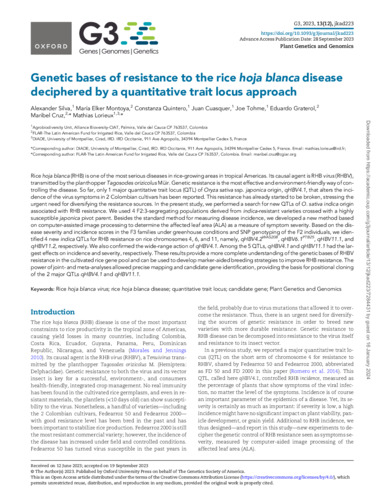Genetic bases of resistance to the rice hoja blanca disease deciphered by a quantitative trait locus approach
Abstract Rice hoja blanca (RHB) is one of the most serious diseases in rice-growing areas in tropical Americas. Its causal agent is RHB virus (RHBV), transmitted by the planthopper Tagosodes orizicolus Müir. Genetic resistance is the most effective and environment-friendly way of controlling the disease. So far, only 1 major quantitative trait locus (QTL) of Oryza sativa ssp. japonica origin, qHBV4.1, that alters the incidence of the virus symptoms in 2 Colombian cultivars has been reported. This resistance has already started to be broken, stressing the urgent need for diversifying the resistance sources. In the present study, we performed a search for new QTLs of O. sativa indica origin associated with RHB resistance. We used 4 F2:3-segregating populations derived from indica-resistant varieties crossed with a highly susceptible japonica pivot parent. Besides the standard method for measuring disease incidence, we developed a new method based on computer-assisted image processing to determine the affected leaf area (ALA) as a measure of symptom severity. Based on the disease severity and incidence scores in the F3 families under greenhouse conditions and SNP genotyping of the F2 individuals, we identified 4 new indica QTLs for RHB resistance on rice chromosomes 4, 6, and 11, namely, qHBV4.2WAS208, qHBV6.1PTB25, qHBV11.1, and qHBV11.2, respectively. We also confirmed the wide-range action of qHBV4.1. Among the 5 QTLs, qHBV4.1 and qHBV11.1 had the largest effects on incidence and severity, respectively. These results provide a more complete understanding of the genetic bases of RHBV resistance in the cultivated rice gene pool and can be used to develop marker-aided breeding strategies to improve RHB resistance. The power of joint- and meta-analyses allowed precise mapping and candidate gene identification, providing the basis for positional cloning of the 2 major QTLs qHBV4.1 and qHBV11.1.

